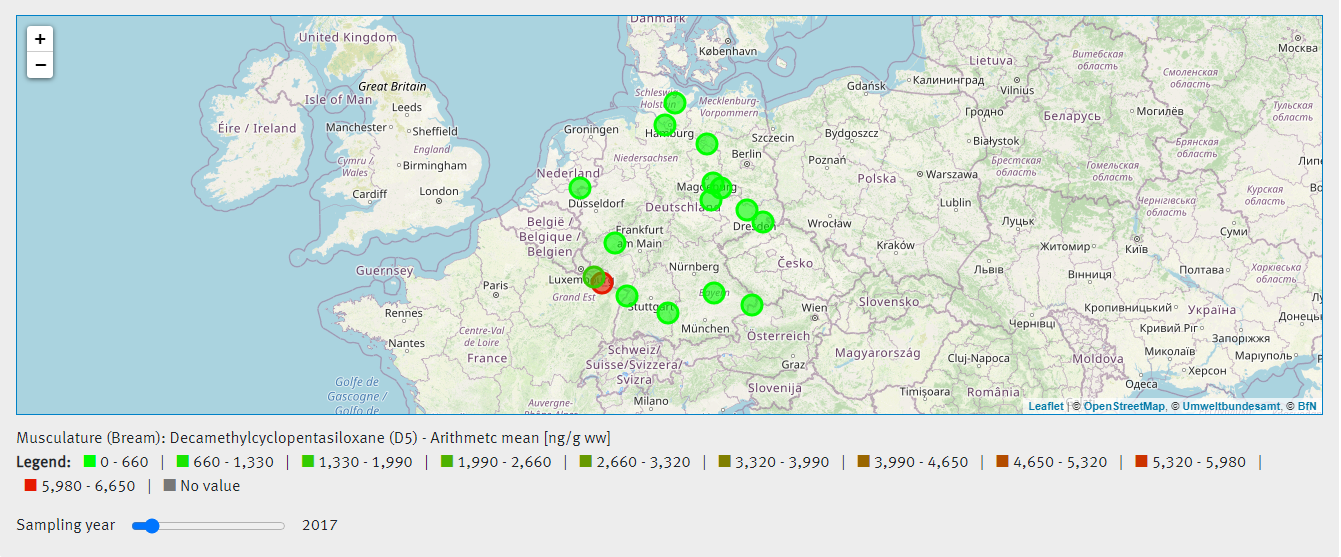Cyclic methylsiloxanes in fish
Fish are particularly heavily contaminated with cyclic methylsiloxanes where industrial companies produce and process the substances.
Cyclic volatile methylsiloxanes (cVMS) are industrially produced industrial chemicals that are used in large quantities, for example as intermediates in the production of silicone plastics or as ingredients in personal care products.
In 2018, the EU REACH authority classified octamethylcyclotetrasiloxane (D4), decamethylcyclopentasiloxane (D5) and dodecamethylcyclohexasiloxane (D6) as substances of very high concern. With fish samples from the German environmental specimen bank, researchers from the Fraunhofer Institute for Molecular Biology and Applied Ecology have elaborated an overview of the current and historical contamination of water bodies. To do this, they used a coupled GC-ICP-MS/MS method and started by spatially comparing the pollution of fish from the Rhine, Saar, Danube, Elbe and tributaries, Lake Belau (Belauer See) in northern Germany and the North Sea and Baltic Sea coasts.
In fish from all sampling sites and over the entire study period, the decamethylcyclopentasiloxane (D5) concentrations were significantly higher than the measured D4 and D6 concentrations. The Saar samples (near the German-French border) were the ones most contaminated with cVMS. Elsewhere, cVMS occurred in high concentrations especially at those sampling sites where industrial plants producing or processing cyclic methylsiloxanes are known in the river basin. This applies to the sampling sites in the Elbe near Dresden, Wettin in the Saale and Jochenstein in the Danube.

The cVMS concentrations in fish from Lake Belau as well as North Sea and Baltic Sea fish were below the detection limits of the analytical method. This also provided evidence that there is no contamination of the samples in the course of routine sampling and processing.
At some selected sites, the temporal trends in fish contamination with cVMS were the subject of investigation. The highest D4 and D5 concentrations were detected in fish fillets from a Saar site in 2009 (approx. 320 and 7,400 ng/g fresh weight). It is striking that in most of the time series analysed, cVMS concentrations peaked between 2007 and 2011. Thereafter, cVMS concentrations in fish decreased considerably. The observed decrease in use is possibly related to the fact that the environmental safety of cyclic methylsiloxanes has also been discussed in European chemical safety bodies since 2009 (for example, in the EU PBT Expert Group) and manufacturers therefore increasingly reduced the use of cVMS.
Evaluation
To enable an assessment of the relevance of the detected cVMS fish tissue concentrations, they were compared with environmental quality standards (EQS) for D4 and D5 derived by Swedish authorities in 2019 for the European Water Framework Directive (WFD). The EQS for D5, which however does not apply in Germany, was exceeded at several sites in several years in the period 2003 - 2011 - for fish from one Saar site until 2017, the last year of the time series.
The time courses of the measured concentrations of D4, D5 and D6 are shown in Figures 2 to 4.



Updated at: 2022-01-12
Recommended profiles
Specimen
-
Bioindicator in rivers and lakes
Analytes
-
Cyclic methylsiloxanes with persistent, bioaccumulative and toxic properties in the environment
Sampling area
-
Fourth largest river basin in Central Europe
-
First sampling site of the river Elbe after crossing the Czech-German border
-
Southernmost sampling site of the Middle Elbe
-
Northernmost sampling site in the Middle Elbe
-
Sampling site upstream of the Elbe estuary
-
Northernmost sampling site of the German upper course of the river Elbe
-
Only sampling site of bream in the river Saale
-
Sampling site of bream in the river Mulde
-
Second largest river in Europe
-
Highest-located ESB sampling site for breams in the river Danube
-
The only sampling site in the German middle course of the river Danube. It forms a bridgehead over the Rhine-Main-Danube Canal to the river Rhine.
-
Last sampling site of the river Danube before the German-Austrian border.
-
The Saar river entering the Saarland conurbation
-
One of the 6 lakes in the Bornhöved Lake District
-
Longest river in Germany
-
Last sampling site in the dammed Rhine before the German-French border
-
Middle Rhine above the Moselle mouth in Koblenz near the German Corner
-
At the German-Dutch border
Extended information
Literature
-
Retrospective analysis of cyclic volatile methylsiloxanes in archived German fish samples covering a period of two decades
Radermacher, Georg; Rüdel, Heinz; Wesch, Charlotte; Böhnhardt, Anna; Koschorreck, Jan
Science of The Total Environment 706 (2020), March, 136011; online 9 December 2019, 2019